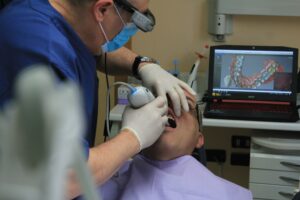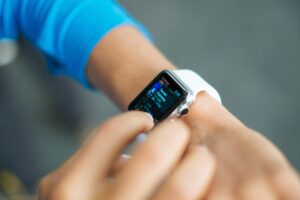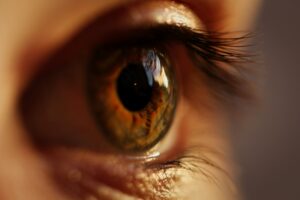Healthcare across the world is using new technologies to improve lives across the globe. We review some of the ways in which IoT, AI and robotics are being adopted, from everyday use to monitor fitness, to early diagnosis of treatable conditions in rural developing areas.
Whether it’s your resting heart rate, cholesterol count or blood pressure, healthcare has always been obsessed with numbers and data.
 Surgeries and hospitals are awash with measurements, charts and test results, with more data being generated now than ever before. As technologies such as artificial intelligence and IoT become more prevalent in our day-to-day lives, that’s only going to increase. But how can they be used to help us live healthier and longer lives?
Surgeries and hospitals are awash with measurements, charts and test results, with more data being generated now than ever before. As technologies such as artificial intelligence and IoT become more prevalent in our day-to-day lives, that’s only going to increase. But how can they be used to help us live healthier and longer lives?
Data to the rescue
A huge range of companies are getting involved in health and fitness, including some of the biggest consumer tech brands in the world, which has kickstarted a whole new wave of health-focused products.
For example, the most recent Apple Watch models include an electrocardiogram feature that measures your heart rate and can detect irregular activity, producing data that can be exported and shown to a doctor. It also has Fall Detection built in and will automatically notify emergency services if it senses significant sudden movement and impact that could indicate the wearer has been involved in an accident and is unable to call for help – like it did recently, in case of Bob Burdett, a biker who flipped his bike at the bottom of Doomsday path, Riverside State Park (Washington DC) and hit his head and lost consciousness.
“The trend for wearable fitness devices, which encourage behavioural changes to keep people healthy, has also led to a rise in lifestyle-focused platforms that combine data from smartphones and IoT devices with AI, to suggest activities and more smartly monitor and manage chronic health conditions.”
 Whereas many of the more basic wearables simply provide a numerical target to hit every day, platforms such as Sweetch use AI to tailor their suggestions to the individual, their habits and routines. Many consumers don’t know that the 10,000 steps a day target stems from a marketing ploy by a Japanese company in 1965 to sell a pedometer! Rather than just a generic step count to meet, Sweetch uses data collected from connected devices to provide contextual, personalised tasks that aim to help users manage their weight, diet and activity around their day-to-day schedule, rather than telling them to stand up when they’re in the middle of an important meeting.
Whereas many of the more basic wearables simply provide a numerical target to hit every day, platforms such as Sweetch use AI to tailor their suggestions to the individual, their habits and routines. Many consumers don’t know that the 10,000 steps a day target stems from a marketing ploy by a Japanese company in 1965 to sell a pedometer! Rather than just a generic step count to meet, Sweetch uses data collected from connected devices to provide contextual, personalised tasks that aim to help users manage their weight, diet and activity around their day-to-day schedule, rather than telling them to stand up when they’re in the middle of an important meeting.
Other platforms, such as Lark, Hello Heart and Livongo, use own-brand connected devices to take readings and collect data from users, with AI transforming them into context-aware, hyper-personalised guidance for patients dealing with diabetes, high blood pressure and other long-term medical conditions. When platforms such as these are clinically validated, they can be used to help medical institutions identify high-risk patients at home and help them to get the treatment they need.
This more connected approach to healthcare also allows for better access to trained medical professionals, particularly in places that might not have regular access to a doctor, let alone specialists.
Beyond wearables
Huawei’s AI for Good initiative has spawned various projects that bring the power of artificial intelligence and augmented reality to more people across the globe. Track.Ai is designed to pick up on the signs of visual impairment in children before they’re even able to explain their symptoms themselves, so they can be treated as early as possible while blindness is still preventable.
 Track.Ai currently uses DIVE (Devices for an Integral Visual Examination) hardware to capture data from a patient’s gaze, which is then analysed using AI to determine the probability of the child developing an ophthalmic condition. Children with damaged vision look at things differently to those without, and in less than 15 minutes, AI-powered devices can detect the telltale patterns more accurately than a doctor’s manual observations.
Track.Ai currently uses DIVE (Devices for an Integral Visual Examination) hardware to capture data from a patient’s gaze, which is then analysed using AI to determine the probability of the child developing an ophthalmic condition. Children with damaged vision look at things differently to those without, and in less than 15 minutes, AI-powered devices can detect the telltale patterns more accurately than a doctor’s manual observations.
The company is now working on a version of this technology that is powered by the onboard AI of one of its smartphones, so it’ll work even where connectivity is unreliable. The aim is to make it usable by non-trained professionals in rural areas, so that children can be screened as early as possible and doctors can focus on treating those that really need it.
Healthcare for all
As artificial intelligence becomes more sophisticated it will also take the strain off overworked medical personnel, allowing data to be collated and analysed more quickly, which will help to inform more accurate diagnoses and decision-making, while also streamlining patient workflows.
“In the grand scheme of things, both AI and IoT are still in their infancy, but with both evolving and improving all the time, their impact on the healthcare world is only likely to grow.”
With more connected devices, especially those on which patients rely to monitor and maintain their health, a strong infrastructure becomes ever more integral. And developing this for countries that may not yet have the best in place, brings with it the opportunity to improve the health of the global population.
As well as its advancements in healthcare, IoT is also helping to save the planet in a number of different ways. Read about it here.
Transformational Hybrid SolutionsOur cloud-enablement services offer the best performance on your traffic-heavy websites or mission-critical applications.
Core NetworksTata Communications™ global IT infrastructure and fibre network delivers the resources you need, when and where you need them.
Network Resources
Unified Communications As A ServiceBreak the barriers of borders efficiently and increase productivity with Tata Communications’ UC&C solutions.
Global SIP ConnectEmpower your business with our SIP network and witness it grow exponentially.
InstaCC™ - Contact Centre As A ServiceCloud contact centre solutions for digital customers experience and agent productivity.
DIGO – Communications Platform as a ServiceDIGO is an in-network cloud communications platform, enabling you to power up converged contextual human-to-everything conversations globally.
Unified Communication Resources Case studies, industry papers and other interesting content to help you explore our unified communications solution better.
IoT SolutionsThe Internet of Things is transforming the way we experience the world around us for good. Find out more about our Internet Of Things related solutions here.
Mobility SolutionsTata Communications’ mobility services enable your enterprise to maintain seamless communication across borders, with complete visibility of cost and usage.
Mobility & IoT Resources
Multi-Cloud SolutionsWith enterprises transitioning to a hybrid multi-cloud infrastructure, getting the right deployment model that yields ROI can be a daunting task.
Cloud ComplianceCompliant with data privacy standards across different countries and is also designed to protect customers’ privacy at all levels.
IZO™ Cloud Platform & ServicesIZO™ is a flexible, one-stop cloud enablement platform designed to help you navigate complexity for more agile business performance.
Managed Infrastructure ServicesIntegrated with our integrated Tier-1 network to help your business grow efficiently across borders.
Cloud PartnersWe support a global ecosystem for seamless, secure connectivity to multiple solutions through a single provider.
Cloud Resources
Governance, Risk, and ComplianceRisk and Threat management services to reduce security thefts across your business and improve overall efficiencies and costs.
Cloud SecurityBest-in-class security by our global secure web gateway helps provide visibility and control of users inside and outside the office.
Threat Management - SOCIndustry-leading threat-management service to minimise risk, with an efficient global solution against emerging security breaches and attacks.
Advanced Network SecurityManaged security services for a predictive and proactive range of solutions, driving visibility and context to prevent attacks.
Cyber Security ResourcesCase studies, industry papers and other interesting content to help you explore our securtiy solution better.
Hosted & Managed ServicesTata Communications provide new models for efficient wholesale carrier voice service management. With our managed hosting services make your voice business more efficient and better protected
Wholesale Voice Transport & Termination ServicesYour long-distance international voice traffic is in good hands. End-to-end, voice access & carrier services which includes voice transport and termination with a trusted, global partner.
Voice Access ServicesTata Communication’s provide solutions which take care of your carrier & voice services, from conferencing to call centre or business support applications.
Carrier Services Resources
CDN Acceleration ServicesOur CDN Web Site Acceleration (WSA) solution helps deliver static and dynamic content, guaranteeing higher performance for your website.
CDN SecuritySafeguard your website data and customers’ information by securing your website from hacks and other mala fide cyber activities.
Video CDNDeliver high-quality video content to your customers across platforms – website, app and OTT delivery.
CDN Resources
Elevate CXIncrease customer satisfaction while empowering your service team to deliver world-class customer experience and engagement.
Live Event ServicesTata Communications’ live event services help battle the share if eyeballs as on-demand video drives an explosion of diverse content available on tap for a global audience.
Media Cloud Infrastructure ServicesTata Communications’ media cloud infrastructure offers flexible storage & compute services to build custom media applications.
Global Media NetworkTata Communications’ global media network combines our expertise as a global tier-1 connectivity provider with our end-to-end media ecosystem.
Use CasesUse cases of Tata Communications’ Media Entertainment Services
Remote Production SolutionsMedia contribution, preparation and distribution are highly capital-intensive for producers of live TV and video content, and their workflows are complex.
Media Cloud Ecosystem SolutionsThe Tata Communications media cloud infrastructure services offer the basic building blocks for a cloud infrastructure-as-a-service.
Global Contribution & Distribution SolutionsTata Communications’ global contribution and distribution solution is built to reduce capital outlay and grow global footprint.
Satellite Alternative SolutionsAs more and more consumers choose to cut the cord & switch to internet-based entertainment options, broadcasters are faced with capital allocation decisions.
LeadershipA look into the pillars of Tata communications who carry the torch and are living embodiment of Tata’s values and ethos.
Culture & DiversityHere at Tata Communications we are committed to creating a culture of openness, curiosity and learning. We also believe in driving an extra mile to recognize new talent and cultivate skills.
OfficesA list of Tata Communications office locations worldwide.
SustainabilityTata Communications adopts a holistic approach and harnesses the power of new-age technologies like 5G, IoT and AI to build a sustainable digital world.
FAQCheck out our FAQs section for more information.
BoardHave a look at our board of members.
ResultsFind out more about our quarterly results.
Investor PresentationsFollow our repository of investor presentations.
FilingsGet all information regarding filings of Tata communications in one place.
Investor EventsAll investor related event schedule and information at one place.
GovernanceAt Tata, we believe in following our corporate social responsibility which is why we have set up a team for corporate governance.
SharesGet a better understanding of our shares, dividends etc.
SupportGet all investor related contact information here.


